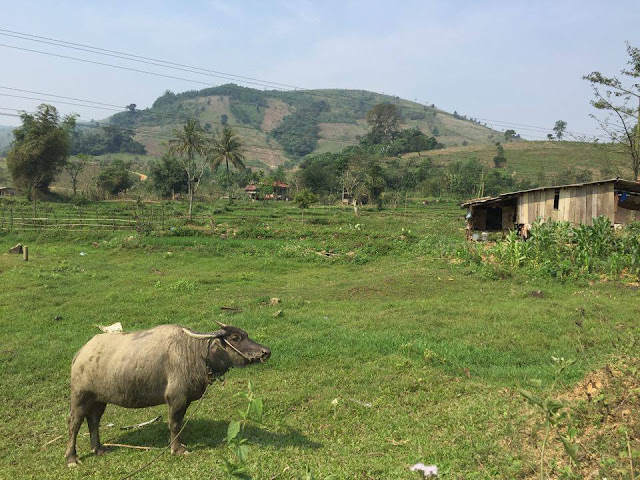On the way to the old capital - Hue - the rest stop was in at a beautiful lake filled with fishing boats and surrounded by towering mountains. We had 30mins to take a break from the bus, grab a snack or go for a walk.

The lakes beauty withered a little when we found a pile hidden in the grass near the shore. It just so happens that someone tried to step in that exact spot (F*$#&?!!).
 |
| poo foot |
 Hue
Hue
An early but quick bus ride got us to Hue in the morning. Buttt.. because we booked the hostel after midnight the night before, we messed up and booked the wrong night. Meaning we were staying in the dorm this time. We explored the city and the Citadel of the old days when it was Vietnam’s capital.

Though it was an interesting historic city we were ready for some more remote locations after the abundance of cities we had seen so far in Vietnam.
So we also booked our ticket out of Hue for the next day. We booked a tour of the Demilitarized zone which was on the way, almost half way to Phong Nga National Park, our next destination.
 |
| Hue Backpacker Hostel |
DMZ - Demilitarized Zone
We got up early again to start out on a tour to the Demilitarized zone, which is the section along the Ben Hai river where Vietnam was split in two (North and South Vietnam) before the American war. Many parts of Vietnam are still said to be dangerous to travel off the trails while exploring as there are still a lot of unexploded ordinance leftover from the war, and there are still casualties each year. Starting in the tour in the town of Dong Ha, we set out to learn about the American war and got to visit some interesting sites.
South of the DMZ - The Rockpile – only accessible by helicopter, where American troops held as a lookout over the surrounding area. The bus pulled off the road and let everyone out for a picture of the mountain from afar.
 |
| Rockpile (Elliot's Combat Base) |
A bridge on the Ho Chi Minh trail over the river was a very important part of the war. The Ho Chi Minh trail was created and used strategically to transport troops, resources and weaponry throughout the country. Much of it hidden through thick jungle territory through Laos and Cambodia. This was a very important aspect in the war and played a major role in the victory. Once again the bus pulled over for pictures.

 |
| Water Buffalo near the bridge |
We stopped at a local village amongst rice paddies. The bus pulled over for pictures of the village.



Then we drove high up into the mountains on the south side of the river where American troops had a base camp - Khe Sanh Combat Base. There were old tanks, planes, choppers, bombs, trenches and bunkers around the area. It was a good place to learn some history and see some old war items as there was also a museum.











 |
| Gimme Dat Aiiiiiiir |
Once everyone got a good look around we hopped back onto the very hot bus
and we crossed the dividing line over to the North of the river to head to the tunnels of Vinh Moc.
 |
| Border between North/South Vietnam over the river (blue/yellow) |
 |
| Peace monument at the river crossing border |
This village of Vinh Moc had been bombed so heavily by the Americans who thought that they were supplying opposing forces in defence to bombers on the way to Hanoi. The inhabitants of the area worked together to build tunnels underground for them all to survive in for the 6year duration.
 | |
| Bomb Crater |
It was amazing the work that they had put into these tunnels. They had different rooms, ventilation tunnels, strategic entrances and 3 different levels, up to 30m deep into the ground. I could never imagine living there for 6 years! Several children were born inside the tunnels during the war.
 |
| small scale of tunnel complex |
 |
| Entrance to level 1 |

 |
| Ventilation tunnel |
 |
| One family's room |



 |
| Entrance to level 2 |



 |
| Entrance to level 3 |
 |
| Seaside near 3rd level of tunnel |


On the way out of Vinh Moc we got to see some of the local ways of living.
Some farm crops.
A lot of the Vietnamese people living in rural areas believe that they live on after death and therefore are buried in the farmland and fields to help watch over their families and crops after they have passed away.
A good example of one of the many wayyyy overloaded vehicles transporting crops ("I'd rather my arms rip off than make another trip!!" type of mentality).
Our next and last stop of the tour was visiting a war memorial graveyard. This graveyard had thousands of unknown/unnamed soldiers buried, which was a very sad sight to see.

 |
| Sniper Jane |
This wrapped up our DMZ tour and we headed back into Dong Ha to wait to catch our bus onward to Phong Nha Ke Bang National Park. It was worth the bargain to wait in Dong Ha rather than return all the way to Hue as it was already on the way to Phong Nha.





















No comments:
Post a Comment